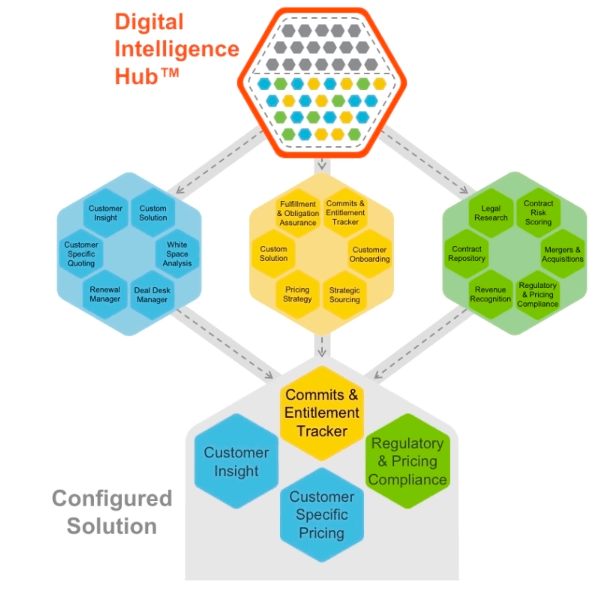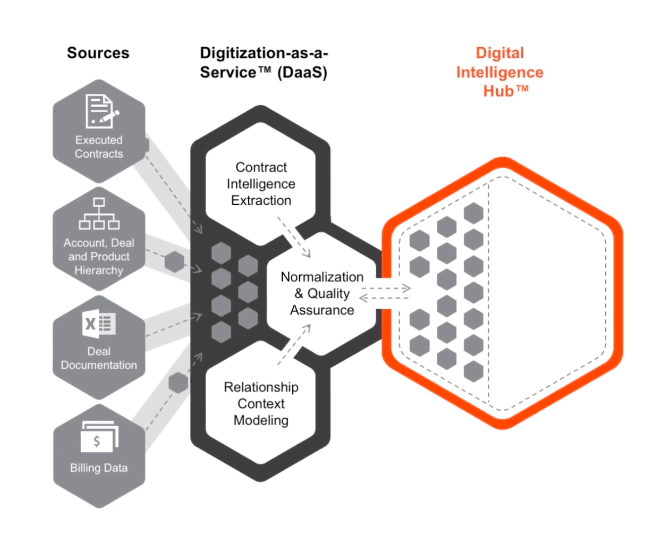
Artificial Lawyer recently caught up with Praful Saklani (pictured above), the CEO of US contract management and data analysis company, Pramata, which is increasingly making use of legal AI technology.
While Pramata may have begun as far back as 2005 it is still very much in growth and exploration mode. Its current focus is best described with their own words: ‘[Pramata offers a] cloud-based Customer Digitisation Platform that helps finance and sales ops leaders at large B2B enterprises unlock vital information to drive revenue.’ But, the exciting part is just how the company is now embracing AI tech.

And, Pramata has some extremely good clients, for example Microsoft, for which it helps manage their vendor contracts, conduct analysis on them for the tech giant off-site and then send back the insights. It also works with NCR, Century Link and HPE.
Saklani points out that although they are effectively working with legal documents, i.e. sales contracts, for example, the insights that the company looks for with natural language processing (NLP) and machine learning are very much focused on giving the client a better understanding of their own client relationships.
This data can relate to sales effectiveness and business performance with those insights then pushed out along the platform to other parts of the client’s business, such as its marketing/BD teams.
The company calls it ‘Digitisation as a Service’ or DaaS, i.e. a client’s mass of unstructured sales data is collected together in one place where it can be constantly updated, analysed and insights fed back to the client’s various departments, which can then exploit this knowledge.

‘The source of all this insight is legal documents,’ says Saklani, ‘but companies find it hard to track all of this. It’s often ad hoc.’
‘We started using machine learning early on, so that our processes were not purely manual and are instead partly automated.’
Saklani adds that for a while they have been focused on sales teams and also finance departments in large companies, but now, as interest in legal AI grows, the legal departments of corporates are also showing an interest, including that of Microsoft.
He explains the aim here is to help companies gain better visibility on their contract data so that they can take action. It can also help with risk and compliance issues around the company’s contracts that its sales team is signing.
With regard to NLP, the company has had several years to develop its own libraries of provisions, as well as collecting together some public, open source ones.
As, Saklani points out: ‘The IP is the training [of the NLP].’
That is to say, the many years spent perfecting the company’s NLP has become something of real value to their clients.

However, he is keen to stress this is not a 100% automated platform, human involvement is key here as well. One clear example is with documents that cannot be wholly put through an OCR system.
This is actually a very critical issue, Saklani says, as no company wants to have gaps in the data set. After all, some of those non-OCR docs could hold vital data, or data that would perhaps change the overall insights of the analysis. Hence, Pramata definitely still relies on people as well.
At present there are around 300 staff globally and having that flexibility is important to Pramata. Or as Saklani says: ‘The end customer may not care if it is AI or people doing the work, they just want to know that it’s accurate.’ At least now the company has the option to use both, or either.
But, what of the future? Saklani may have been running the business for over a decade but it seems that everything is still changing rapidly.
‘In nearly every company we talk to AI is a CEO issue,’ he notes.
In fact, he adds that it would be surprising if some of the tech companies they work with did not start to develop their own AI applications that could be relevant to legal work. He also notes, that although AI tech such as NLP is not necessarily a simple thing, the real asset is the data. Having great data to train NLP systems on to reach the levels of accuracy and machine learning that a client wants is one of the biggest challenges.
The real asset is the data
Looking more broadly at the use of AI systems in a legal context Saklani has some progressive ideas. He notes that sales teams don’t necessarily have to refer what appear to be legal matters to the legal team if AI systems can set out the key issues.
‘The real issue is how you interface with legal questions,’ he states, and this then leads into the area of using legal tech to help ‘non-lawyers’, AKA most other people in a company.
‘A lot of legal AI at the moment is all about helping lawyers. But it would be great to use AI to democratise legal information in a way so that non-lawyers can take action,’ he adds.
This is a big area for further exploration and perhaps shows just how much more the use of legal AI could grow in the years ahead among corporate clients. Meanwhile, for Saklani there is plenty to do right now with his client’s growing needs for data insights and guiding the steady evolution of his company from one that once largely helped manage information to one that delivers real business knowledge through AI-led analysis.
1 Trackback / Pingback
Comments are closed.